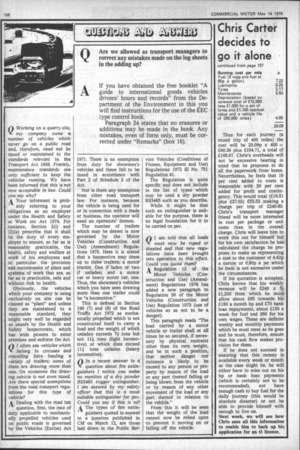ai r tt i ) ‘AAJAU
Page 160

If you've noticed an error in this article please click here to report it so we can fix it.
Are we allowed as transport managers to correct any mistakes made on the log sheets in the adding up?
If you have obtained the free booklet "A guide to international goods vehicles drivers' hours and records" from the Department of the Environment in this you will find instructions for the use of the EEC type control book.
Paragraph 24 states that no erasures or additions may be made in the book. Any mistakes, even of form only, must be corrected under "Remarks" (box 16).
QWorking on a quarry site, my company owns a number of vehicles which never go on a public road and, therefore, need not be taxed or maintained to the standards relevant to the Transport Act 1968. Frankly, maintenance standards are only sufficient to keep the vehicles running. We have been informed that this is not now acceptable in law. Could you say why? A Your informant is prob ably referring to your obligations as an employer under the Health and Safety at Work etc Act 1974. For instance, Section 2(i) and (2)(a) prescribe that it shall be the duty of every employer to ensure, so far as is reasonably practicable, the health, safety and welfare at work of his employees and in particular the provision and maintenance of plant and systems of work that are, so far as is practicable, safe and without risk to health.
Obviously, the vehicles which your company is using exclusively on site can be classed as "plant" and unless they are maintained to a reasonable standard, they might very well be regarded as unsafe by the Health and Safety Inspectorate, which has wide powers to enter premises and enforce the Act.
QI often see vehicles which belong to circuses and travelling fairs hauling a variety of trailers; some of them are drawing more than one. On occasions the drawing vehicle is not even taxed. Are there special exemptions from the road transport regulations for this type of vehicle? A Dealing with the road tax question, first, the rate of duty applicable to mechanically propelled vehicles used on public roads is governed by the Vehicles (Excise) Act 1971. There is no exemption from dutyfor showmen's vehicles and these fall to be taxed in accordance with Part 2 of Schedule 3 of the Act.
Nor is there any exemption from other road transport law. For instance, because the vehicle is being used for or in connection with a trade or business, the operator will need an operators' licence.
The number of trailers which may be drawn is now governed by the Motor Vehicles (Construction and Use) (Amendment) Regulations 1975. Here it is stated that a locomotive may draw up to three trailers; a motor tractor. One if laden or two if unladen; and a motor car or heavy motor car, one. Thus, the showmen's vehicles which you have seen drawing more than one trailer could be "a locomotive."
This is defined in Section 190 (7) and (8) of the Road Traffic Act 1972 as mechanically propelled which is not constructed itself to carry a load and the weight of which unladen exceeds 71 tons but not 11i tons (light locomotive) or which does exceed 11 tons unladen (heavy locomotive).
QIn a recent answer to a question about fire extinguishers I notice you make no mention of a dry powder BS3465 trigger extinguisher. I am assured by my safety officer that this is a most suitable extinguisher for psv. Could you say if this is so? A The types of fire extin guishers quoted in answer to a question published in CM on March 12, are those laid down in the Public Ser vice Vehicles (Conditions of Fitness, Equipment and Use) Regulations 1972 SI No. 751 Regulation 41, The Regulation is quite specific and does not include in the list of types which may be used a dry powder BS3465 such as you describe.
While it might be that such an extinguisher is suitable for the purpose, there is no legal foundation for it to be carried on psv.
QI am told that all loads 11C must now be roped or sheeted and that new regulations have been brought into operation to this effect. Could you quote them? A Regulation 12 of the Motor Vehicles (Construction and Use) (Amendment) Regulations 1976 has added a new paragraph to Regulation 90 of the Motor Vehicles (Construction and Use) Regulation 1973 (use of vehicles so as not to be a danger).
This paragraph reads "The load carried by a motor vehicle or trailer shall at all times be so secured, if necessary by physical restraint other than its own weight, and be in such a position, that neither danger nor nuisance is likely to be caused to any person or property by reason of the load or any part thereof falling or being blown from the vehicle or by reason of any other movement of the load or any part thereof in relation to the vehicle."
From this it will be seen that the weight of the load cannot now be relied upon to prevent it moving on or falling off the vehicle.




























































































































































































































